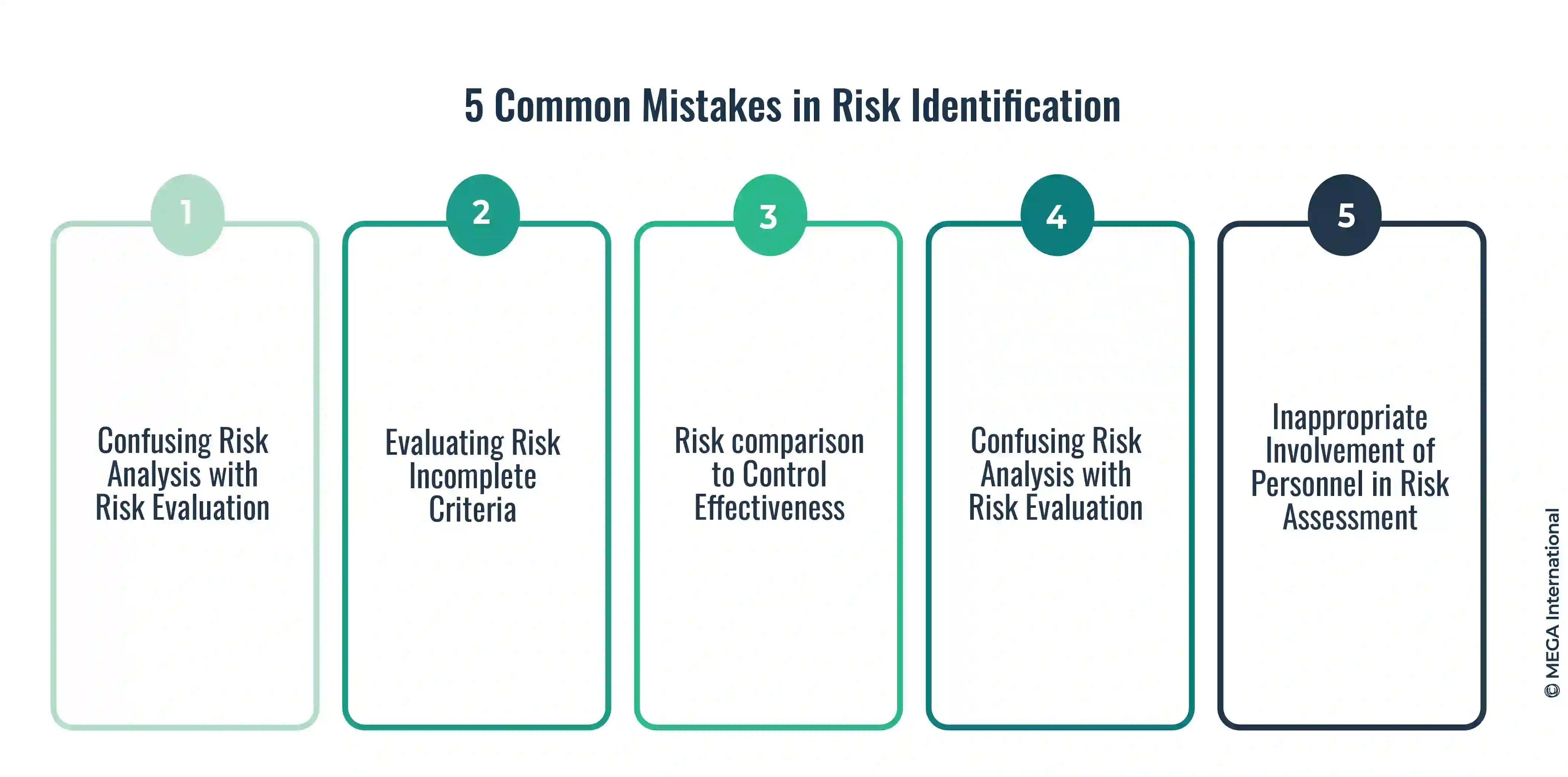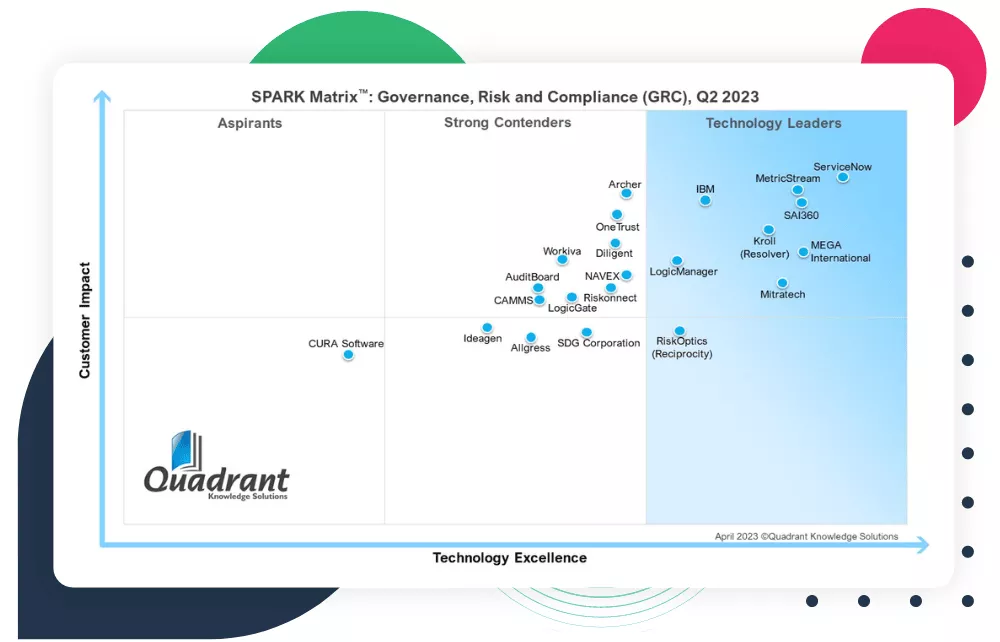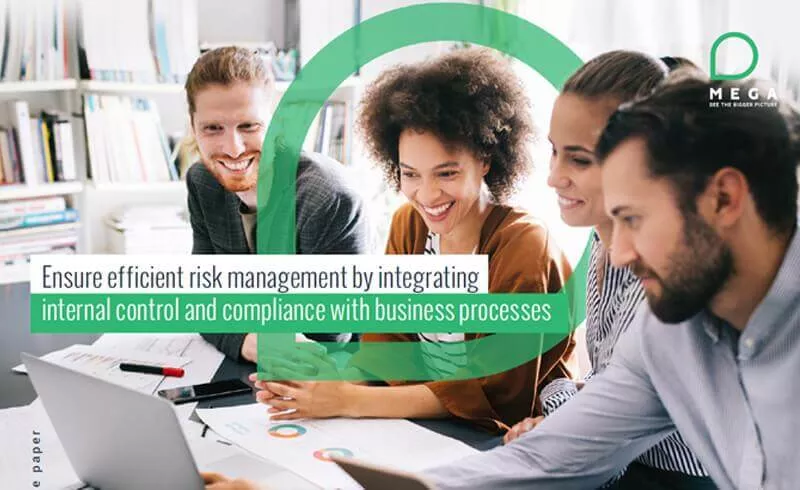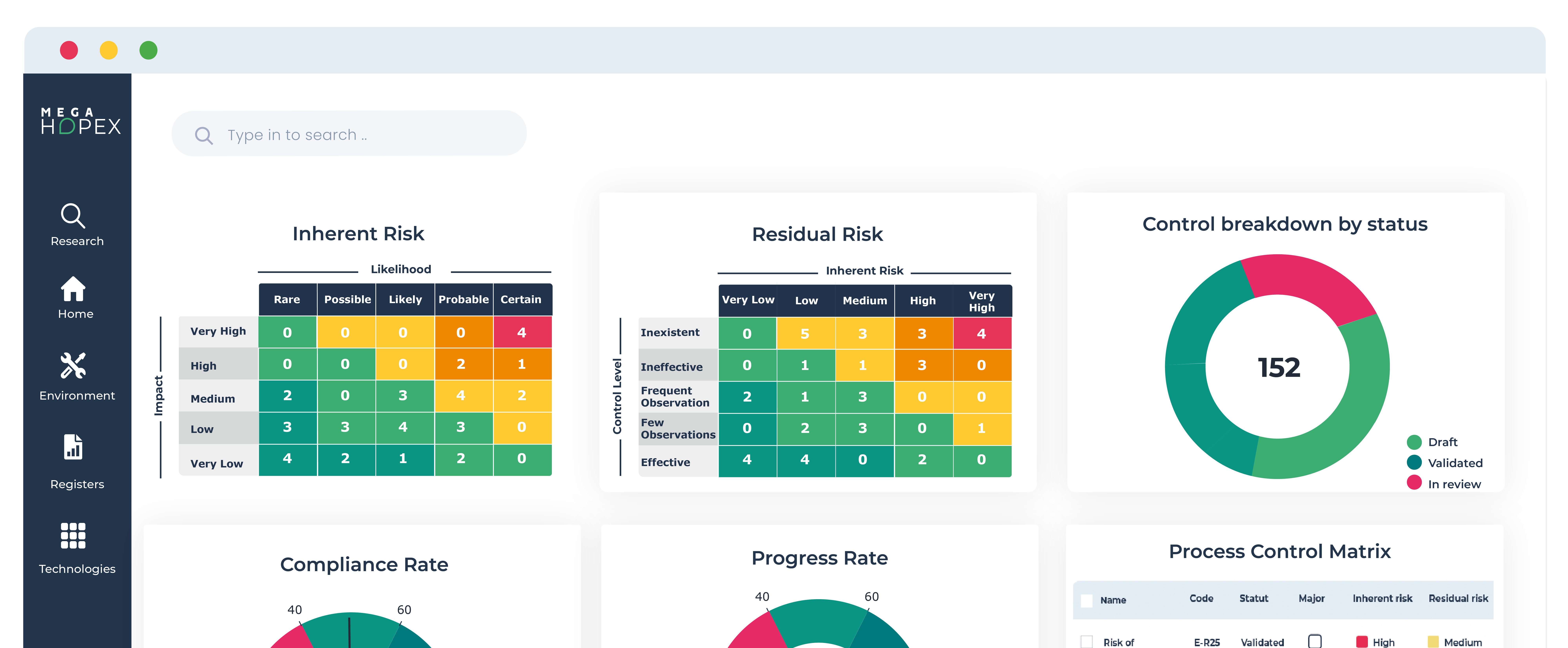
10 Common Mistakes in Risk Identification, Analysis, and Evaluation
All enterprises encounter risks requiring diligent recognition, analysis, and adept management—nonetheless, commonplace aspects within risk management demand rectification by organizations. To evade these pitfalls, one must meticulously comprehend the risks confronting one's business and judiciously allocate resources.
Effective risk management mandates a proactive stance, a comprehensive grasp of the business ecosystem, and an unwavering willingness to derive insights from previous errors. Businesses can limit their exposure to potential risks by prioritizing risk management while advancing their strategic objectives.
Adopting a comprehensive and holistic perspective of your business ecosystem is instrumental in ascertaining the extent of risk exposure and guaranteeing adherence to regulatory requirements proactively before any detrimental impact ensues. While the initial ten mistakes highlighted are not the sole concerns for risk professionals, myriad approaches exist to identify, analyze, and evaluate risks. The nature of these risks can vary depending on the specific context, industry, and lines of business.
Nevertheless, irrespective of their categorization, there are prevalent errors in risk management that must be vigilantly sidestepped. Presented below are ten critical mistakes warranting careful attention.

1: Confusing Risk Analysis with Risk Evaluation
Risk analysis identifies the causes and potential impacts of risk qualitatively. For example, you're driving down the highway when suddenly you get a flat tire! You try to figure out what could have caused it: tire pressure, driving too fast, poor road conditions, a nail in the tire, etc. Then, you consider the immediate and long-term consequences: your safety and those around you, financial impacts, long-term damage to your car, legal ramifications, etc. The causes and impacts are part of the risk analysis.
Risk evaluation is when you define the seriousness of the risk about other risks. It is the quantitative part of the risk assessment. Returning to the driving analogy, getting a flat tire is a risk worth paying attention to, but how does that compare with the risk of a head-on collision or skidding on ice? Understanding the risks associated with your business and how to prioritize them will allow you to allocate resources most appropriately.
Recognizing the difference between risk analysis and evaluation is vital to determine when to apply each practice.
2: Inappropriate Involvement of Personnel in Risk Assessment
Involving the right stakeholders in the risk assessment process is crucial. Using the driving analogy, the risk assessment must include people familiar with the car and the potential consequences of a flat tire while driving.
Without this specific experience, they may not be able to accurately assess the potential ramifications, such as the car violently pulling to one side or losing control of the vehicle. Ideally, a person with prior experience and a comprehensive understanding of the potential outcomes would be responsible for analyzing and evaluating the risks associated with a flat tire.
One way to improve risk assessment accuracy is to use a tool that consolidates all relevant data and information about end-users and their roles, providing the necessary context to identify, analyze, and evaluate risk effectively.
3: Mistaking Risk Factors for the Actual Risk
A risk factor is a contributing element that can increase the probability of a risk occurring, but it does not equate to the risk itself. For instance, under-inflated tires, unpredictable weather, or potholes in the road do not guarantee a flat tire.
However, they can raise the chances of experiencing one. Differentiating between "risk factors" and "risk" helps to identify the causes and implications of specific business actions. This understanding enables stakeholders to develop appropriate proactive and reactive measures to incorporate into strategic plans to prevent, minimize, or mitigate potential risks.
4: Evaluating Risk Without Context
To ensure practical risk assessment, it is crucial to establish company-defined objectives as a basis for identifying and evaluating risks.
The risk assessors should clearly understand the company's objectives to conduct an analysis aligned with the overall business goals.
It is essential to avoid assessing risks based on personal risk appetite, as this can result in a misalignment with the company's objectives.
To facilitate this process, it is recommended to implement an integrated solution that includes organizational, strategic, operational, and cost-related information to help identify, analyze, and assess risks accurately. This solution will enable the communication of vital information to the relevant stakeholders at the right time and enhance the value of the risk management program.
5: Risk Comparison to Control Effectiveness
When managing risks, it's crucial to avoid comparing the risk to the effectiveness of implemented controls. Instead, the focus should be on understanding how the controls impact and reduce inherent risks into residual risks. This requires an input-driven identification process that prioritizes risks based on their potential impact on business objectives.
In the example of driving, the risk is getting a flat tire, and the controls include regular tire checks, taking alternate routes to avoid damaged roads, keeping an active AAA membership, and so on. By understanding the difference between the risks and the controls, you can accurately assess the situation and prioritize the controls' effectiveness to manage the risks effectively.
A comprehensive solution that integrates organizational, strategic, operational, and cost information is necessary.
This solution helps to identify, analyze, and assess risks and prioritize controls' effectiveness to mitigate and manage the risks. Ultimately, the identification process and appropriate allocation of resources enable you to manage risks proactively and ensure business objectives are met.

6: The Importance of Differentiating Between Gross Risk and Net Risk
In risk management, it's essential to distinguish between gross risk, also known as inherent risk, and net risk, or residual risk. Gross risk refers to the level of risk before implementing controls and other mitigating factors, while net risk is the level of risk after implementing all measures and controls.
However, determining these two types of risks is not always straightforward, especially when the rules are not well-defined or accessible to the assessor.
Without a clear management plan, risk assessors may fail to recognize that their net risk is lower than they perceive. This can result in inefficient resource allocation towards risks already under control rather than those requiring greater attention.
For instance, in our previous example, risk assessors usually implement preventive measures such as regular tire maintenance, monitor risk status through air pressure indicators on the car dashboard, and prepare reactionary/response measures like tire repair kits in the trunk. Tracking the changes to controls, the number of risks, and associated risks becomes too complicated to manage using a simple spreadsheet or similar tool.
To mitigate these challenges, a dedicated risk management platform provides a global view of the input, associated risks, and mitigation strategies, enabling effective management of gross and net risks. This platform also simplifies tracking changes to controls and automates the assessment process to identify areas where the risk management plan needs improvement. By having a comprehensive view of global risks, you can prioritize and allocate resources effectively towards areas that require greater attention, resulting in a robust risk management strategy.
7: Setting new controls without verifying the effectiveness of existing controls
Risk managers tend to add more controls to put in place and manage significant risks without adequately identifying and assessing the list of controls already in place. It's essential to consider the controls in place before introducing new ones. By involving control owners in risk management, their knowledge and expertise can help identify and assess risks more effectively.
To avoid Mistake #7, which involves overlooking existing controls, risk managers should collaborate with control owners and maintain a 360-degree view of information to centralize and connect all data related to risk management. This approach can help ensure that all significant risks are adequately identified, assessed, and managed with appropriate controls.
8: Adopting a risk management approach focusing solely on reducing or eliminating risks.
Effective risk management involves more than just reducing or eliminating risks. Other strategies include transferring, sharing, accepting, or even increasing risks. To apply these strategies effectively, gathering information on implementation costs, potential impacts, setup time, and other relevant factors is crucial.
A comprehensive risk governance system is beneficial when managing particular risks, especially when considering increasing an identified risk. Since risk is an inherent aspect of business that can affect all areas at any level, it's crucial to understand its context to manage business expectations and achieve goals. Therefore, managers or a group of experts should identify situations where accepting or increasing certain risks could benefit the business.
The risk register and overall risk profile must be considered to accomplish this. Brainstorming sessions, audits, and regularly reviewing measures in place are vital to identifying and managing risks.
9: Failure to Regularly Update Risk Assessments
Many organizations make the mistake of over-controlling their critical risks, which can be problematic if the controls are outdated. If too much time goes by without reviewing controls, it becomes easy to lose sight of why they are in place and whether they are still necessary.
This can lead to addressing risks that are no longer relevant or low priority. While updating information from various Excel spreadsheets can be daunting, it's integral to regularly review controls and their relevance to risk identification and treatment.
Many companies still manually review their controls and struggle to identify instances of over-controlling. Organizations should consider using a dynamic tool that provides a central view of the various controls connected to identified risks, updated in real-time to be more efficient and effective.
This method enables businesses to stay current and manage risks effectively without unnecessarily impeding operations. If your company is willing to take this approach, a risk management solution can provide a valuable and efficient way.
Discover Concerning the Implication of: Breaking Silos to Ensure Success in Risk Management
10: Neglecting the proposed risk treatment plan
Taking preventative measures to reduce the risk of a flat tire, such as checking tire pressure, is critical to any risk management plan. It would be unwise to ignore this step after investing time and effort into developing a risk management strategy.
Similarly, it's essential to evaluate the impact of the preventative measures after identifying and analyzing risks. While monitoring risks is the most crucial step in risk management because it produces tangible results, it's often neglected.
To address this issue, consider using a tool that integrates with other action plans, such as quality, performance, and compliance, and has monitoring alerts set up. This will help prevent Mistake #10 and ensure that risk monitoring remains integral to the overall risk management strategy. Considering any already implemented measures and their relevance to the current risk landscape is essential. Organizations that are reluctant to monitor risks regularly run the risk of neglecting their proposed risk treatment plan, which could have severe consequences for the company in the long run.
Learn About AI-Driven Risk Assessment in GRC
Summary
We've identified the most common mistakes to avoid in risk identification, analysis, and assessment. Are you experiencing any of these scenarios? MEGA offers a comprehensive solution for risk management with a 360ᵒ view of all risk management processes. You can accurately determine your risk exposure and ensure regulatory compliance, all while saving time and resources.
Don't let risk management hold you back. With MEGA, you can determine your risk exposure and ensure regulatory compliance with a 360ᵒ view of all risk management processes. To learn more about HOPEX Operational Risk Management and see how we can help you stay ahead of the game.
FAQs
Some common mistakes in risk identification include failing to identify all potential risks, underestimating the likelihood or impact of a threat, and relying solely on experience or assumptions.
Risk assessment evaluates the likelihood and impact of identified risks to prioritize them for further analysis and mitigation.
There are numerous ways to identify risks, including brainstorming sessions, surveys, stakeholder interviews, historical data review, and industry trends analysis.
Common mistakes to avoid in the risk identification process include failing to involve all relevant stakeholders, not considering global or megatrends, and focusing too narrowly on one particular risk instead of considering the overall risk landscape.
Residual risk remains after controls have been implemented to mitigate a particular risk. It is crucial to consider residual risk in the overall risk management process.
Common mistakes to avoid in the risk identification process include:
- Failing to involve all relevant stakeholders.
- Not considering global or megatrends.
- Focusing too narrowly on one risk instead of considering the overall risk landscape.
A risk management plan outlines an organization's strategy for identifying, evaluating, and mitigating risks. It is essential to regularly review and update the project to ensure effectiveness in managing risks.
Critical risks are those risks that could have a significant impact on an organization if they were to occur. Identifying and assessing critical risks is essential to the overall risk management process.
Risks should be evaluated based on their likelihood and potential impact. This can be done through a qualitative or quantitative analysis or a combination of both, depending on the risk.
Risk mitigation is implementing controls or strategies to reduce the likelihood or impact of a particular risk. It is an important step in the overall risk management process.
Identifying and analyzing risks is an important activity in any project or business. It helps you to anticipate and mitigate potential issues before they become serious problems. By identifying risks early on, you can take proactive measures to minimize their impact and avoid costly delays or failures. Analyzing risks enables you to prioritize them and create a plan of action to address them most effectively. While risk identification and analysis can be time-consuming and challenging, it is far less daunting than dealing with the consequences of ignored risks later. Ultimately, investing time and effort in risk assessment can help you to ensure the success of your project or business.
The final step in the risk identification process is documenting the identified risks. This involves creating a risk register or log that lists all the risks identified during the risk identification process and their potential impact and likelihood. A risk register is a comprehensive tool for managing and monitoring risks throughout the project or program lifecycle. It enables project teams to prioritize risks and develop appropriate risk responses and mitigation strategies to minimize their potential impact. By documenting the identified risks, the team can communicate them to stakeholders and other project participants and ensure they are adequately addressed. This step is crucial in ensuring that risks are properly managed, and the project or program remains on track. Failure to document and monitor risks can lead to costly delays, resource depletion, and even project failure.
Risk identification is a crucial part of risk management, identifying, evaluating, and mitigating potential risks that may impact a business or project. Risk identification involves the systematic process of identifying, assessing, and recording all potential risks that may impact any aspect of your business or project. Identifying potential risks makes it easier to determine the best approach to manage them effectively. Risk identification requires a thorough understanding of all the activities, stakeholders, and systems involved in the project or business. The process of risk identification may involve brainstorming with team members, reviewing historical data, conducting interviews and surveys, analyzing performance reports, and studying more extensive industry or market trends. Risk identification helps to ensure that necessary steps and measures are taken to avoid or mitigate potential risks before they occur.
Ensure efficient risk management and operational resiliency
Governance, Risk and Compliance Related Content
Enhance operational resilience using integrated risk management
MEGA HOPEX for GRC
Request a demonstration of HOPEX for GRC, and see how you can have immediate value of your projects.









